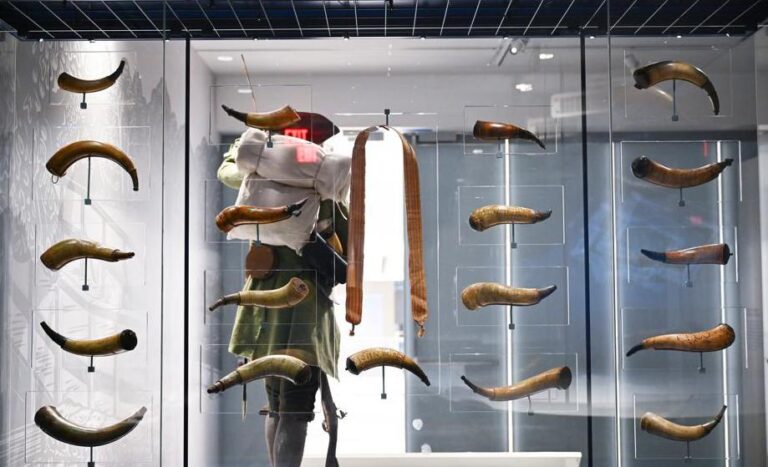Paul Morando lifted the lid on the wooden crate that had been shipped to the National Museum of the US Army from England the night before. He paused, took a pair of blue gloves from a coat pocket, and put them on.
He and an assistant, Lisa Noll, removed the crate’s two inner covers. They pulled out the white packing paper. And Morando, the museum’s chief curator, lifted out the 275-year-old sword.
“There it is,’’ he said — The sword of British General Charles Cornwallis that, experts theorize, was presented to the Americans during the British surrender at Yorktown on Oct. 19, 1781. (Cornwallis himself never showed up.)
It was the sword that “represents the birth of America,’’ Caroline Stanley, Britain’s Countess of Derby and a Cornwallis descendant, said at the museum last week.
Though they cannot be absolutely certain, experts think this was the sword that signified the end of the Revolutionary War, Morando said, a physical object that symbolized victory over British oppression after six years of bloody conflict.
The sword is part of a new museum exhibition, “Call to Arms: The Soldier and the Revolutionary War,’’ that celebrates the Army’s 250th birthday Saturday and the nation’s 250th next year.
The exhibition opened June 7 at the museum in Fort Belvoir, Va., about 15 miles south of D.C. It is set to run through June 2027.
The British surrender came as the forces of Washington and his French allies trapped the main part of Cornwallis’s Army at Yorktown, a village on the York River in southeastern Virginia.
The exhibition includes a large collection of muskets, pistols — two of which belonged to Washington — etched powder horns, rare uniforms, tattered battle flags, and mannequins clad in period garb.
One of the faded flags is that of the 1st Rhode Island Regiment, which included a large contingent of Black soldiers, many of whom were enslaved and agreed to fight in exchange for their freedom. One of them was Cato Varnum, who is shown as a life-size figure wearing the regiment’s white uniform and black hat.
Another flag, that of the German Ansbach-Bayreuth Regiment in the employ of the British, was the last banner surrendered at Yorktown, Morando said.
More than 2,000 hired German soldiers surrendered with the British, the museum says.
Morando has assembled artifacts from institutions around the country, as well as military museums in Britain, France, and Canada.
From Britain came the sword, which has been lent by the countess, who said her family has owned it for generations. She watched last week as it was mounted in a museum display case.
Morando said that there is no concrete proof that this was the Cornwallis sword presented at the ceremony but that there is “a lot of supporting evidence.’’
In paintings depicting the surrender, the sword is “just a simple British officer’s sword. And that’s what this is. There’s nothing fancy. Just a standard English dress sword from that time period.’’
“I honestly believe this is Lord Cornwallis’s sword,’’ he said. “Whether or not it was the sword that was presented, you can make arguments for and against. Looking at the research, looking at the documents, looking at the images, and paintings, you can make a strong argument that this indeed is the surrender sword.’’
The countess said, “It’s never left the family.’’
“It was always in my father’s dressing room,’’ she said in an interview. “Probably not being looked after in the way that it should have been looked after. It was in a coat stand with … umbrellas and stuff like that.’’
“Even though he knew how important it was … it’s always been much more of a sentimental item,’’ she said.
The sword, which is on loan for six months, is believed to have been given to Cornwallis in his youth by an uncle who was a general, she said. The sword dates to the 1750s.
By 1781, Cornwallis was 42 and a battle-tested leader when he surrendered his army at Yorktown.
The ceremony that Friday afternoon took place in front of thousands of soldiers — victors and vanquished. Washington was present. So was the French commander, Rochambeau.
Cornwallis was not. He was either too embarrassed or was ill, historian Jerome A. Greene wrote in his 2005 book “The Guns of Independence: the Siege of Yorktown, 1781.’’
Although the countess said, Cornwallis and Washington met privately later, the British general’s absence at the surrender annoyed the Americans.
